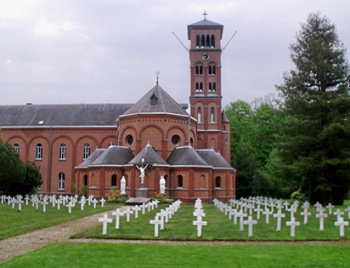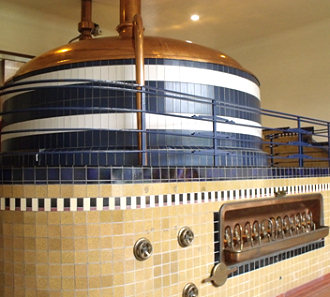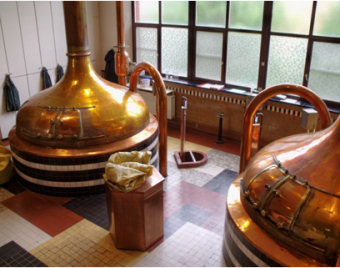 |

|
|

|
|
|
 |

home
about
features
A-Z
books

|

|

features
|

| |
Westmalle
by Willard Clarke, 06/10
It's one of the wonders of the modern beer world that in a tiny part of Europe Trappist monks take time from their prayers to make small batches of ale of the highest quality
that are promoted by word-of-mouth, not advertising. The country in question is Belgium. To visit a Trappist brewery there is to take a journey back in time when the pace of
life was slower and more thoughtful, and the pursuit of communal work was placed above the clamour for profit.
The abbey of Westmalle, a few miles north of Antwerp, is one of six Trappist monasteries in Belgium that still make beer. The monks find that their exquisite ales are talked
about and sought after by a growing number of discriminating drinkers throughout the world. Westmalle is especially highly regarded, as the abbey has given names to its main
products - Dubbel and Tripel - that have become recognised styles. The abbey's double and triple are frequently copied but rarely if ever surpassed.
| The abbey's full name is Our Beloved Lady of the Sacred Heart. It's reached by an arrow-straight, narrow road from the village of Westmalle, the buildings half-hidden by tall
elm trees that act as sentinels against the outside world. Away from the roar of traffic on the Antwerp-Turnhout road, you are struck by the silence and solemnity of the majestic
abbey and its grounds. The only sound is bird song. The word "stilte" (silence) appears on many doors. Visitors are greeted by the monks with warm smiles but a finger to the lips.
|
|
 |
Westmalle is, fundamentally, a place of worship and contemplation. The monks follow the simple edict of St Benedict: ora et labora -- pray and work. A few words are spoken to
visitors but silence is the rule. It was a strange experience to eat both supper and breakfast without exchanging a word with my fellow diners. The atmosphere is quickly
absorbed and I found myself tip-toeing down corridors and closing doors as though they were made of fragile glass.
 |
|
One aspect of the abbey was familiar to me: the delicious aroma of toasted grain and yeast that told me beer was being made. At the rear of the abbey, the brewery stands in
sharp distinction to the rest of the buildings. The characteristic smooth curves indicate that the brewery was designed and built in the 1930s in the popular Art Deco style of the time.
Can a brewhouse be beautiful? Pale sunshine pours in through high windows, picking out two burnished copper kettles. They are fed by a large mash tun standing proud above them
on a raised platform. All three vessels have tiled bases picked out in a pattern of black, blue and red.
|
The first brewery at Westmalle opened in 1836. The current brewhouse dates - as the architecture shows - from the 1930s. It was upgraded in the early 1990s when the brewing vessels
were re-lined but they retain their original, striking appearance.
This is classic ale brewing. Water comes from the abbey's own wells. It's hard and the iron is removed before it's used for brewing. The water is mixed in the mash tun with malt
that comes from barley grown in the Beauce-Gatinais region of France, south of Paris. The mash lasts for an hour as starch in the grain is transformed in to sugar. The spent grains
are used as cattle feed on the monks' farm. The sugary extract or wort is then run into the kettles below where it's boiled with whole flower hops: the monks feel that the hop plant
in its natural form delivers the finest aroma and flavour. The favoured variety is the Czech Saaz but some Tettnanger from the Bavarian Hallertau and Styrian Goldings are also
used: the hops are added three times during the boil. The kettles are heated by direct flame, a method that leads to some slight caramelisation of the malt with a resulting hint of
butterscotch or toffee in the finished beer.
 Dubbel is brewed with pale Pilsner malt and well-roasted dark malt. Dark candy sugar is added in the kettles. Tripel is made with pale Pilsner malt only and white candy sugar.
Following the kettle boil, the hopped wort is cooled and yeast and sugar are added prior to fermentation in closed vessels. The yeast strain is the original one from the 19th
century: I was invited to drink a small glass as - I was assured -- it would be good for both my digestion and my skin. It was creamy, intensely bitter and delicious, the perfect
pick-me-up.
Primary fermentation lasts for a week. The beer is then filtered and re-seeded with fresh yeast and sugar. It enjoys a second fermentation and conditioning in tanks - three weeks for
Dubbel and five for Tripel. The beer is finally blended from different tanks and a further dosage of yeast and sugar is added prior to bottling. Only 5% of Westmalle beer is sold
in draught form from kegs and the Tripel is never available on draught. Dubbel accounts for the bulk of production but Tripel is catching up fast in popularity.
The large, modern bottling hall is surprisingly quiet. You are reminded that this is a monastery. Hanging panels in the ceiling deflect and retain noise. The bottled beer is stored
in an underground cellar, again designed to minimise sound. The beers are warm conditioned at 21 degrees Celsius. Dubbel stays in the cellar for two to three weeks, Tripel for three
to four.
Dubbel is brewed with pale Pilsner malt and well-roasted dark malt. Dark candy sugar is added in the kettles. Tripel is made with pale Pilsner malt only and white candy sugar.
Following the kettle boil, the hopped wort is cooled and yeast and sugar are added prior to fermentation in closed vessels. The yeast strain is the original one from the 19th
century: I was invited to drink a small glass as - I was assured -- it would be good for both my digestion and my skin. It was creamy, intensely bitter and delicious, the perfect
pick-me-up.
Primary fermentation lasts for a week. The beer is then filtered and re-seeded with fresh yeast and sugar. It enjoys a second fermentation and conditioning in tanks - three weeks for
Dubbel and five for Tripel. The beer is finally blended from different tanks and a further dosage of yeast and sugar is added prior to bottling. Only 5% of Westmalle beer is sold
in draught form from kegs and the Tripel is never available on draught. Dubbel accounts for the bulk of production but Tripel is catching up fast in popularity.
The large, modern bottling hall is surprisingly quiet. You are reminded that this is a monastery. Hanging panels in the ceiling deflect and retain noise. The bottled beer is stored
in an underground cellar, again designed to minimise sound. The beers are warm conditioned at 21 degrees Celsius. Dubbel stays in the cellar for two to three weeks, Tripel for three
to four.
 Nobody at Westmalle knows where the designations Dubbel and Tripel come from. The beers were first called, simply, brown and blond. From its inception, the brewery always made a
brown beer. The revered former head brewer, Father Thomas, added blond in the 1950s. The change of names to Dubbel and Tripel possibly reflects the fact that some other Trappist
breweries produced a lower strength beer called Single and Westmalle was keen to stress the distinctiveness of its own brews.
As the beers are bottle conditioned, they will change and improve over time. A note of banana in a young Tripel will diminish in bottle. Father Thomas believed his beers were at
their best between three and six months but were still in good form after two or three years.
Dubbel, 7% alcohol by volume, is russet coloured, with a chocolaty, spicy aroma and palate. There are hints of coffee and guava and other tropical fruits. For a strong dark beer,
it's surprisingly hoppy and bitter, with a dry finish balanced by rich malt and fruit.
Tripel, 9.5%, is a hazy orange colour with a floral, Saaz-inspired aroma and tart citrus fruit and banana. It has a tangy, fruity palate balanced by big spicy hops and a long,
lingering finish with warming alcohol, resinous hops, a herbal hint and a big punch of hop bitterness. For a beer of this strength, it's remarkable to find that its bitterness
measures between 35 and 38 units. Both beers are available in 33cl and 75cl bottles - the bigger bottles have attractive corks and cradles. Connoisseurs believe the beers improve
and mature in different ways in the two bottle shapes.
Nobody at Westmalle knows where the designations Dubbel and Tripel come from. The beers were first called, simply, brown and blond. From its inception, the brewery always made a
brown beer. The revered former head brewer, Father Thomas, added blond in the 1950s. The change of names to Dubbel and Tripel possibly reflects the fact that some other Trappist
breweries produced a lower strength beer called Single and Westmalle was keen to stress the distinctiveness of its own brews.
As the beers are bottle conditioned, they will change and improve over time. A note of banana in a young Tripel will diminish in bottle. Father Thomas believed his beers were at
their best between three and six months but were still in good form after two or three years.
Dubbel, 7% alcohol by volume, is russet coloured, with a chocolaty, spicy aroma and palate. There are hints of coffee and guava and other tropical fruits. For a strong dark beer,
it's surprisingly hoppy and bitter, with a dry finish balanced by rich malt and fruit.
Tripel, 9.5%, is a hazy orange colour with a floral, Saaz-inspired aroma and tart citrus fruit and banana. It has a tangy, fruity palate balanced by big spicy hops and a long,
lingering finish with warming alcohol, resinous hops, a herbal hint and a big punch of hop bitterness. For a beer of this strength, it's remarkable to find that its bitterness
measures between 35 and 38 units. Both beers are available in 33cl and 75cl bottles - the bigger bottles have attractive corks and cradles. Connoisseurs believe the beers improve
and mature in different ways in the two bottle shapes.
 There's a third beer brewed at Westmalle. Extra (4.8%) is only for the monks' consumption. Without donning a habit and tonsure, I was permitted a taste and can report that it's a
delightfully hoppy, spicy and refreshing beer.
Westmalle produces 120,000 hectolitres of beer a year - around 72,000 barrels. It's second in size to Chimay, the monastery in the French-speaking region of Belgium. The monks at
Westmalle have no plans for growth. They are satisfied they make sufficient income from their beer to help fund their work in the community. The size of the brewing operation means
the monks have had to hand over day-to-day operations to lay workers. But the brothers remain firmly in charge: they conduct weekly tastings, while a monthly board meeting discusses
production and sales.
Visits to the brewery are permitted but only in small groups: 03 312 92 00. On the main Antwerp road and opposite the entrance to the abbey, the monks own the Cafe Trappisten
(487 Antwerpsesteenweg: open daily 9.00-24.00) where visitors can eat robust local dishes and drink the beers. A popular drink in the cafe is "half and half", a blend of Dubbel and
Tripel. The result is an amber red beer, less peppery than Tripel, but fruity with a good hop bitterness and a dry finish. Visitors can also watch a video film about the abbey and
its brewery.
There's a third beer brewed at Westmalle. Extra (4.8%) is only for the monks' consumption. Without donning a habit and tonsure, I was permitted a taste and can report that it's a
delightfully hoppy, spicy and refreshing beer.
Westmalle produces 120,000 hectolitres of beer a year - around 72,000 barrels. It's second in size to Chimay, the monastery in the French-speaking region of Belgium. The monks at
Westmalle have no plans for growth. They are satisfied they make sufficient income from their beer to help fund their work in the community. The size of the brewing operation means
the monks have had to hand over day-to-day operations to lay workers. But the brothers remain firmly in charge: they conduct weekly tastings, while a monthly board meeting discusses
production and sales.
Visits to the brewery are permitted but only in small groups: 03 312 92 00. On the main Antwerp road and opposite the entrance to the abbey, the monks own the Cafe Trappisten
(487 Antwerpsesteenweg: open daily 9.00-24.00) where visitors can eat robust local dishes and drink the beers. A popular drink in the cafe is "half and half", a blend of Dubbel and
Tripel. The result is an amber red beer, less peppery than Tripel, but fruity with a good hop bitterness and a dry finish. Visitors can also watch a video film about the abbey and
its brewery.
In the beginning...
Trappist monks are properly known as the Order of the Strict Observance, a branch of the Cistercians. The name Trappist comes from their abbey at La Trappe in Normandy, northern
France, from where they were driven out at the time of the French revolution in the 18th century. They settled in the Low Countries - today's Belgium and Netherlands - where they
were given land by benefactors to build new churches. Simple priories developed over time into large abbeys with breweries attached.
The six remaining Trappist breweries are Achel, Chimay, Orval, Rochefort, Westmalle and Westvleteren in Belgium and Koningshoeven in the Netherlands.
The origins of Westmalle stress the problems facing monks at the tumultuous time of the French revolution. Three monks from La Trappe planned to escape to Switzerland and travel
on to Canada. But the revolutionaries had blockaded all the ports and the monks had to abandon their plans. They accepted an offer from the Bishop of Antwerp to
establish a religious community in his diocese. A farmer at Westmalle donated land to the monks, who were joined by other refugees from France and together they started to build
a simple church that developed into an impressive abbey.
A brewery was added in 1836. At first it supplied only the monks' needs but in 1865 it was extended in order to sell beer commercially. Funds were needed for the upkeep
of the abbey and to help finance a Trappist community in the Belgian Congo. Sales were restricted to the Westmalle area until the 1920s. The beers became better known in the 1930s
when the Abbot of Westmalle, Edmond Ooms, gave them the title of Trappisten beer. This brought them to the attention of a wider audience and today there's growing interest in the
beers from all seven Trappist abbeys in the Low Countries.
|
|
|
home
about
features
A-Z
books
|

